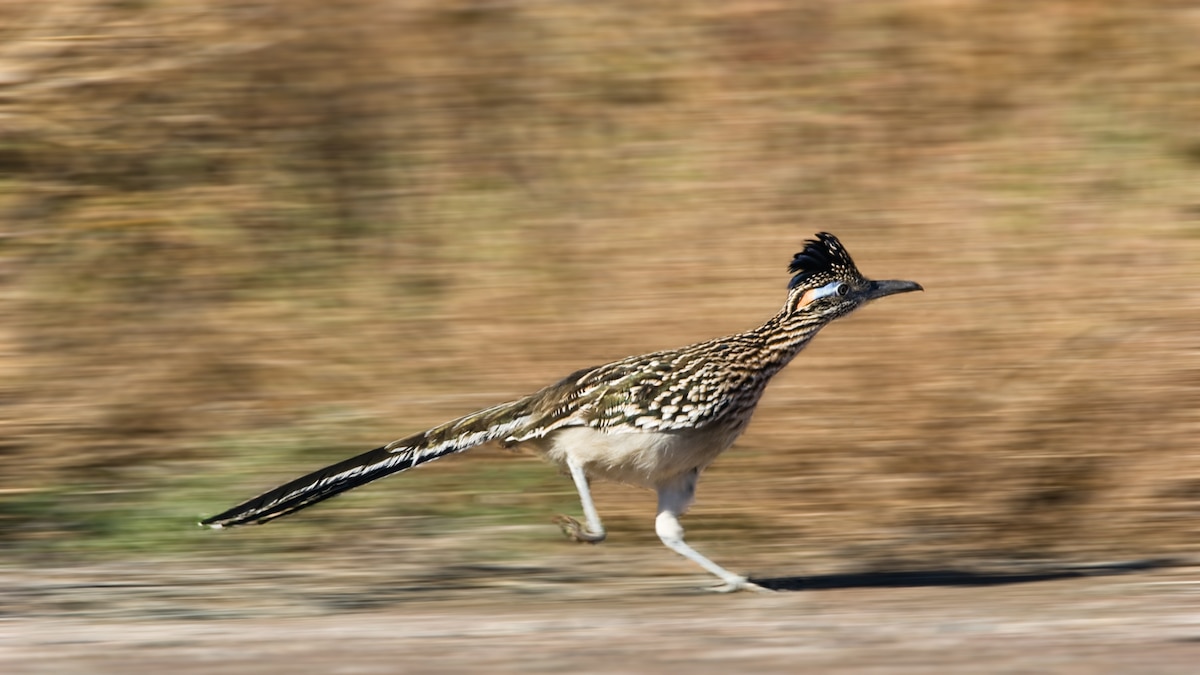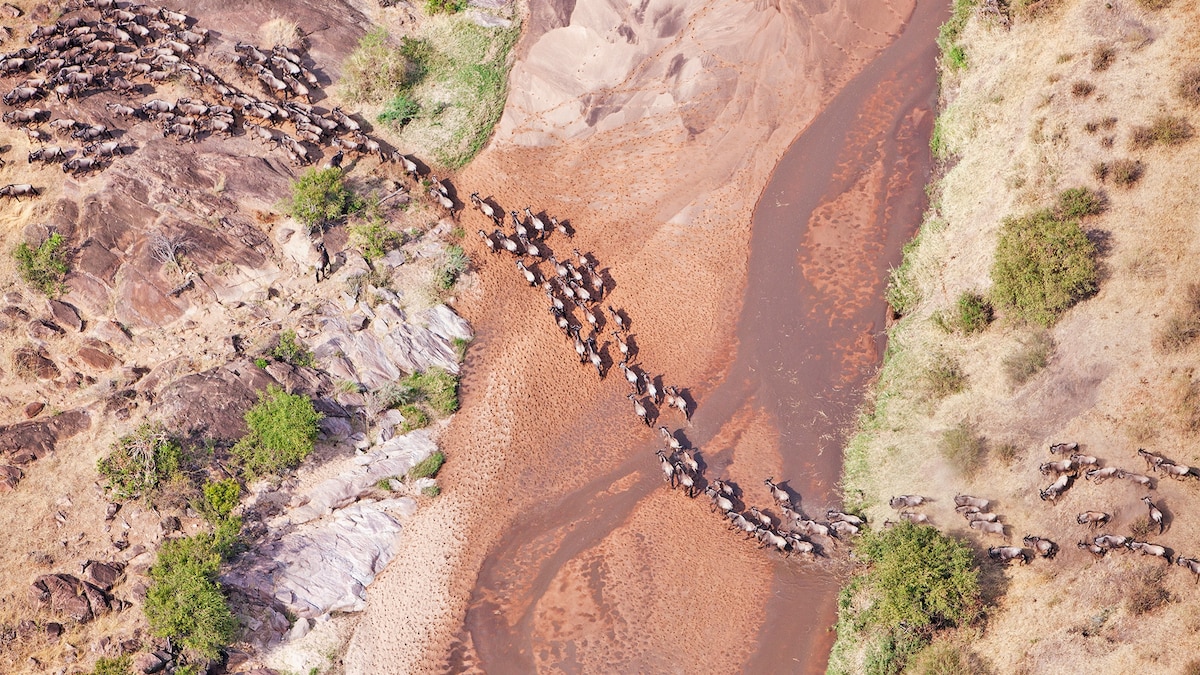Now Reading: A roadrunner in your neighborhood? It’s a growing possibility.
-
01
A roadrunner in your neighborhood? It’s a growing possibility.
A roadrunner in your neighborhood? It’s a growing possibility.

About a decade ago, Mary Taylor Young and her husband were pulling into the driveway of their cabin, a property nestled at 6,700 feet, in southern Colorado. Suddenly, they saw a face that they weren’t expecting: a roadrunner, with its signature spiky head crest and baby blue coloring around the eyes.
“My husband and I were both like, ‘Oh, my God, what is a roadrunner doing here?’” Young, a biologist and nature writer, says. “‘Dude, you belong in the desert. What are you doing?’”
Young says its wasn’t unheard of to see roadrunners in and around the nearby town of Trinidad, Colorado, which sits at about 6,000 feet in the northernmost part of the roadrunner’s range in the state. However, she was surprised by this higher altitude sighting, something that’s becoming more common.
The greater roadrunner is native to the American Southwest and parts of northern Mexico. This bipedal bird can often be seen running through cities like Albuquerque, Phoenix, and El Paso, searching for small lizards, mice, insects, and other food sources. But now it’s turning up more frequently in new areas as it expands its range due to climate change.
Roadrunners, coming to a neighborhood near you
Young has documented the species that visit her property over the last three decades, chronicling them in her book, Bluebird Seasons: Witnessing Climate Change in My Piece of the Wild. She says roadrunner sightings are steadily increasing on her property and in and around Trinidad.
Mike Rader, wildlife education supervisor with the Kansas Department of Wildlife and Parks, is seeing similar changes in his state. “There have been increased sightings of greater roadrunners in Kansas, especially in the last couple of decades,” he says. “While I don’t know if it is a true range expansion, they have been reported further north in the state, even into central Kansas.”
According to maps provided by Chuck Otte, a Kansas bird record keeper, there had been credible historical sightings reported for the bird in 26 Kansas counties by 1989. By 2025, that number had grown to over 50 counties.
Rader says the swell in reporting could be in part due to more widespread internet and greater cell phone and camera access in recent decades. Still, “in my gut, I do feel that there are more here now than when I started birding over 40 years ago,” he says.
Nate Swick, an ornithologist and digital communications manager for the American Birding Association, says it’s happening in Missouri too. “Back when I was growing up in southwest Missouri in the ’90s, roadrunners were really scarce,” he says. “Sometimes people would see them down around Branson, but they were few and far between. Now 30 years later, they’re fairly regular nesting birds in that part of the state, though still infrequently seen.” He adds that the birds are turning up further north and east in recent years.
Swick recalls one particular experience seeing a pair in a neighborhood in Springfield, a town in the Ozark Mountains, during a trip home in 2014. “It’s a bird you usually associate with desert landscapes, so it was wild to see them walking around on green lawns,” he says.
According to ABC Birds, the greater roadrunner has already extended its range eastward as far as Arkansas and Louisiana over the last century. The National Audubon Society predicts that the species will further expand its northern range by 27 percent with 3 degrees of warming, a threshold that some scientists expect us to cross as early as 2070. This would mean more roadrunner sightings in places like Houston, northern Nevada, and up Colorado’s front range nearly as far north as Denver.
Meanwhile, in places like New Mexico, where the roadrunner reigns as the state bird, it seems to be benefitting from even drier conditions, which are expected to increase with climate change. According to Jon Hayes, director of Audubon Southwest, roadrunner populations spiked in the state in the 2010s, which he says is likely correlated to drought conditions experienced across much of the Southwest in that timeframe.
“And that’s the big story here with the roadrunner is that as a changing climate pushes more hot and dry conditions, those critters that are adapted to hot and dry conditions are going to probably do pretty good in the short term there,” he says.
Winners and losers
Seeing new roadrunner neighbors moving into communities might appeal to many people. Rader says most Kansans who come across these quirky birds are “truly excited” to encounter them.
You May Also Like
“Personally, I always enjoy seeing them,” he says. “They are still considered a novelty here in Kansas.”
While a drier and hotter landscape puts many wildlife at risk, roadrunners can take advantage of a warming world thanks to number of adaptive traits. For one, they’re able to obtain water from their food sources instead of drinking and can secrete a concentrated salt solution through a gland near their eyes, helping them to conserve water.
Plus, roadrunner’s have one more advantage when it comes to taking on environmental challenges that might stymy other species—their bird brains. “They’re smart and adaptable,” Swift concludes.
However, Hayes warns that the conditions that are helping roadrunners expand their range aren’t worth celebrating. “We don’t necessarily want to see those arid conditions extended to too many of those areas, because the species that are in those areas are going to lose out,” Hayes says.
In fact, the National Audubon Society’s 2019 Survival by Degrees report found that two-thirds of North American birds are at risk of extinction from global temperature rise.
“Whenever we’re thinking about the change in climate, we do have to recognize that there are going to be winners and losers from this,” Hayes says. “Roadrunners are one that likely benefit from more of the country looking like the arid Southwest.”
Young believes one of these “losers” in her area is the broad-tailed hummingbird, a species she is seeing less frequently at her cabin’s feeders. Meanwhile, another hummingbird species—the black-chinned—seems to be becoming more dominant there. The broad-tailed hummingbird, whose fragmented range is limited mostly to mountains in the West and parts of Mexico, is highly vulnerable to climate change, according to Audubon.
And as savvy as they are, even roadrunners will eventually top out when it comes to spreading to new habitats, Hayes predicts. “Sure, they’ll expand north, but they’re not going to go up into the Rocky Mountains,” he notes. “I mean, they’re not going to go up into the pine forest. They’ll hit their limits as well.”























